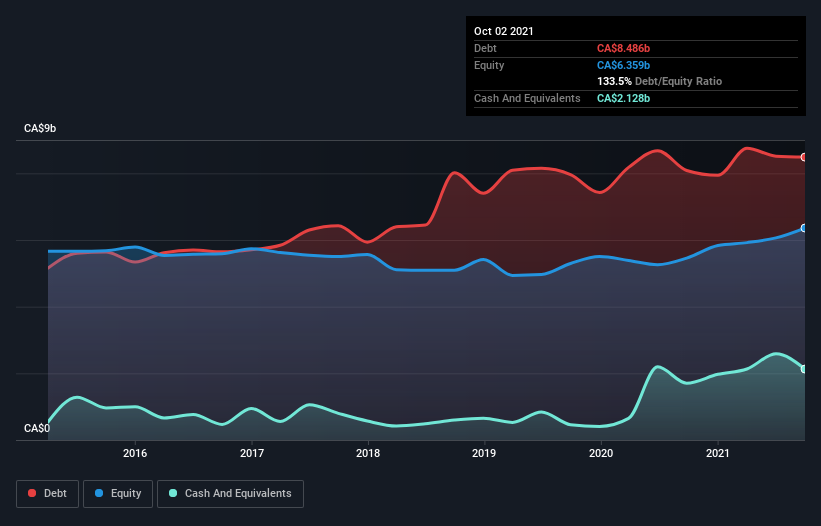Canadian Tire Corporation (TSE:CTC.A) Seems To Use Debt Quite Sensibly
Warren Buffett famously said, 'Volatility is far from synonymous with risk.' So it might be obvious that you need to consider debt, when you think about how risky any given stock is, because too much debt can sink a company. Importantly, Canadian Tire Corporation, Limited (TSE:CTC.A) does carry debt. But is this debt a concern to shareholders?
Why Does Debt Bring Risk?
Debt is a tool to help businesses grow, but if a business is incapable of paying off its lenders, then it exists at their mercy. Part and parcel of capitalism is the process of 'creative destruction' where failed businesses are mercilessly liquidated by their bankers. However, a more common (but still painful) scenario is that it has to raise new equity capital at a low price, thus permanently diluting shareholders. By replacing dilution, though, debt can be an extremely good tool for businesses that need capital to invest in growth at high rates of return. When we examine debt levels, we first consider both cash and debt levels, together.
View our latest analysis for Canadian Tire Corporation
What Is Canadian Tire Corporation's Net Debt?
As you can see below, at the end of October 2021, Canadian Tire Corporation had CA$8.49b of debt, up from CA$8.09b a year ago. Click the image for more detail. On the flip side, it has CA$2.13b in cash leading to net debt of about CA$6.36b.

A Look At Canadian Tire Corporation's Liabilities
Zooming in on the latest balance sheet data, we can see that Canadian Tire Corporation had liabilities of CA$6.54b due within 12 months and liabilities of CA$8.66b due beyond that. Offsetting this, it had CA$2.13b in cash and CA$860.8m in receivables that were due within 12 months. So it has liabilities totalling CA$12.2b more than its cash and near-term receivables, combined.
When you consider that this deficiency exceeds the company's CA$11.3b market capitalization, you might well be inclined to review the balance sheet intently. In the scenario where the company had to clean up its balance sheet quickly, it seems likely shareholders would suffer extensive dilution.
In order to size up a company's debt relative to its earnings, we calculate its net debt divided by its earnings before interest, tax, depreciation, and amortization (EBITDA) and its earnings before interest and tax (EBIT) divided by its interest expense (its interest cover). This way, we consider both the absolute quantum of the debt, as well as the interest rates paid on it.
With net debt to EBITDA of 2.8 Canadian Tire Corporation has a fairly noticeable amount of debt. On the plus side, its EBIT was 8.5 times its interest expense, and its net debt to EBITDA, was quite high, at 2.8. It is well worth noting that Canadian Tire Corporation's EBIT shot up like bamboo after rain, gaining 53% in the last twelve months. That'll make it easier to manage its debt. The balance sheet is clearly the area to focus on when you are analysing debt. But it is future earnings, more than anything, that will determine Canadian Tire Corporation's ability to maintain a healthy balance sheet going forward. So if you want to see what the professionals think, you might find this free report on analyst profit forecasts to be interesting.
Finally, while the tax-man may adore accounting profits, lenders only accept cold hard cash. So the logical step is to look at the proportion of that EBIT that is matched by actual free cash flow. During the last three years, Canadian Tire Corporation produced sturdy free cash flow equating to 72% of its EBIT, about what we'd expect. This cold hard cash means it can reduce its debt when it wants to.
Our View
Canadian Tire Corporation's EBIT growth rate was a real positive on this analysis, as was its conversion of EBIT to free cash flow. On the other hand, its level of total liabilities makes us a little less comfortable about its debt. Considering this range of data points, we think Canadian Tire Corporation is in a good position to manage its debt levels. But a word of caution: we think debt levels are high enough to justify ongoing monitoring. When analysing debt levels, the balance sheet is the obvious place to start. However, not all investment risk resides within the balance sheet - far from it. For example - Canadian Tire Corporation has 1 warning sign we think you should be aware of.
Of course, if you're the type of investor who prefers buying stocks without the burden of debt, then don't hesitate to discover our exclusive list of net cash growth stocks, today.
New: AI Stock Screener & Alerts
Our new AI Stock Screener scans the market every day to uncover opportunities.
• Dividend Powerhouses (3%+ Yield)
• Undervalued Small Caps with Insider Buying
• High growth Tech and AI Companies
Or build your own from over 50 metrics.
Have feedback on this article? Concerned about the content? Get in touch with us directly. Alternatively, email editorial-team (at) simplywallst.com.
This article by Simply Wall St is general in nature. We provide commentary based on historical data and analyst forecasts only using an unbiased methodology and our articles are not intended to be financial advice. It does not constitute a recommendation to buy or sell any stock, and does not take account of your objectives, or your financial situation. We aim to bring you long-term focused analysis driven by fundamental data. Note that our analysis may not factor in the latest price-sensitive company announcements or qualitative material. Simply Wall St has no position in any stocks mentioned.
About TSX:CTC.A
Canadian Tire Corporation
Provides a range of retail goods and services in Canada.
Excellent balance sheet established dividend payer.
Similar Companies
Market Insights
Community Narratives





